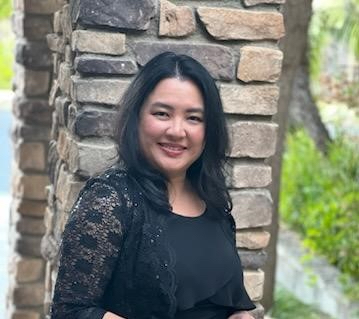“Conclave” Confidential: Production Designer Suzie Davies on Recreating One of the World’s Most Secretive Events
“Hell arrives tomorrow when we bring in the cardinals,” quips the fair-minded Cardinal Lawrence (Ralph Fiennes), the dean of the College of Cardinals, on the eve of the gathering to elect the new Pope. After the unexpected death of the current pontiff, it is Lawrence’s duty to oversee the titular Conclave, when over 100 cardinals from around the world gather to witness the cutthroat battle of succession steeped in tradition and secrecy.
In this riveting Vatican-set election thriller, director Edward Berger (All Quiet on the Western Front) takes us behind the veil into one of the most clandestine events in the world. As the deliberations begin, the cardinals are sequestered in their dormitories at the Casa Santa Marta for the duration of the conclave. On the cusp of profound change for the Catholic Church, several frontrunners emerge to pit the progressive camp against the hardline conservatives.
Oscar-nominated production designer Suzie Davies (Saltburn, The Courier) had her work cut out for her on this film. Since the Vatican does not allow filming at the Sistine Chapel or the Casa Santa Marta, replicas were built at the Cinecittà Studios in Rome. “The whole film is a jigsaw puzzle of locations in Rome and studio builds. We built the elements of the Sistine Chapel with the amazing craftsmen at Cinecittà and the rooms and corridors of the Casa Santa Marta,” Davies recalls. The six-month project included a core team of 20-25 people, in addition to approximately 100 plasterers, painters, construction staff, and set decorators.
Was the crew mostly local?
Yes, the craftsmanship is absolutely out of this world. It was fantastic having people with the knowledge there. Cinecittà is an amazing studio; it felt very exciting driving through those gates every day and working across Studio 5, the famous [Federico] Fellini stage.
What was it like to bring this sacrosanct process to life for the screen?
We know so much about the Vatican, but there’s a hidden side of the conclave that no one really knows. That works to our advantage because we can do our own thing to a certain extent. The tradition is well-documented, but not what happens behind the scenes. So, we ran with our artistic license to create that more brutal fascist architecture of this prison-like Casa Santa Marta. All their secretive meetings and underhand tactics were fun to play with in the corners of these buildings.
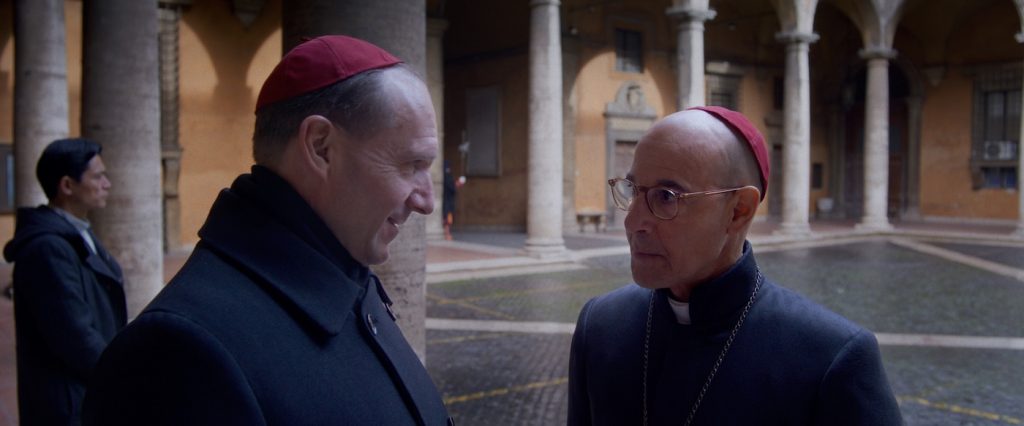
Director Edward Berger talks about balancing light and dark, masculine and feminine, and traditional and contemporary in this film. How does that play into your designs?
This film is about juxtapositions between what we think we know and what we don’t. We discussed playing with those elements to create a more dramatic visual story. Rome is beautiful with amazing ornate architecture, but it also has contemporary architecture that we decided to play with. The feminine shapes and gold, softer side were juxtaposed against hard black lines, and the whites, blues, and blacks against the gold and rich reds.
Those long hallways at Casa Santa Marta felt stifling—you’ve talked about wanting it to feel like a posh prison.
That’s a set built in Cinecittà, along with elements from some locations. That’s so great that you get that feeling. We wanted it to feel hermetically sealed—there was no fresh air since they couldn’t open the windows. So, all you could hear was the hum of fluorescent lights and the air conditioning, and those noises clattered around those corridors. I wanted them to look great, so I built the longest corridor I could. We looked for that location but couldn’t find the scale and design. So, we built it at Cinecittà on a long rectangular stage.
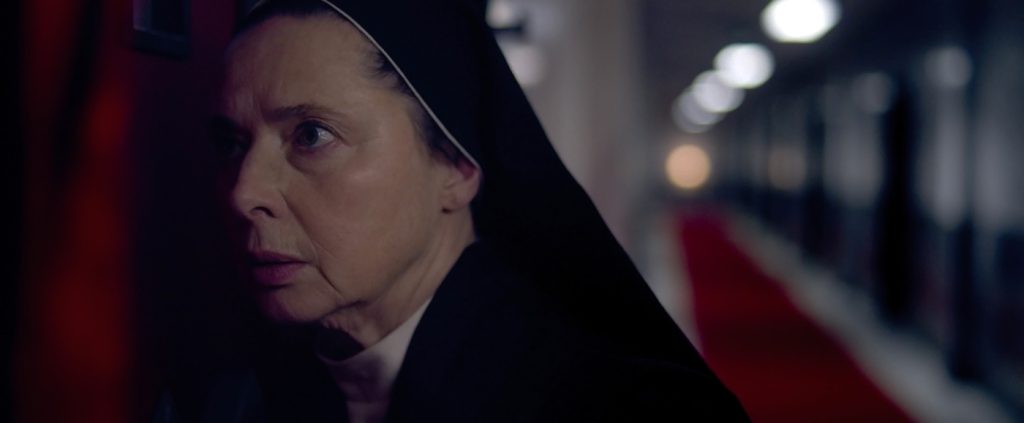
What made the Cardinals’ quarters feel cold, rigid, and bleak?
With those rooms, I was inspired by Italian architect Carlo Scarpa. Those little squares on the doors became a theme, which I think intimate the prison door. There’s no ornamentation or decorative moldings on the walls; it’s all very neat, brutal, and sharp.
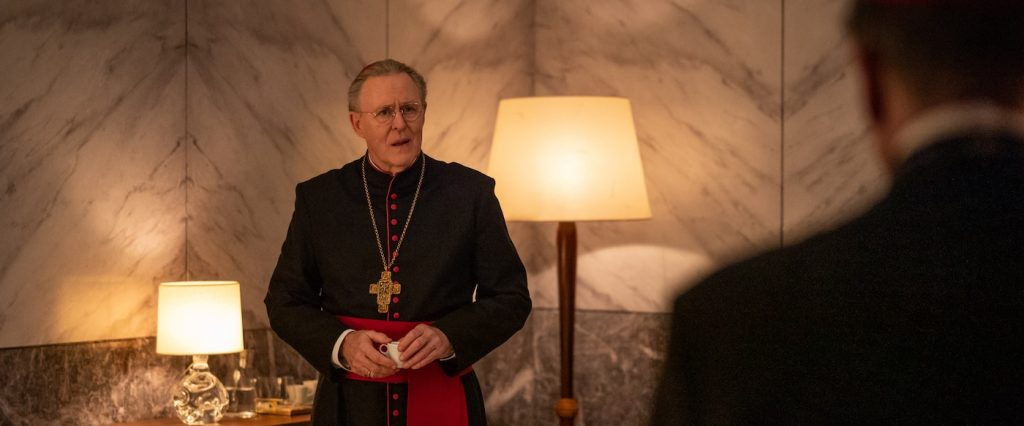
Some of the revelations and tension occur during routine activities, such as meals in the dining hall and in the stairwells and hallways.
It’s interesting to see them in all their pomp and amazing costumes in the canteen or going up the stairs. Seeing them in unusual spaces gives the sense that it’s all happening right now. Often, the images of the conclave can be a Renaissance painting, like a Caravaggio. You think it happened ages ago, but it could happen right now.
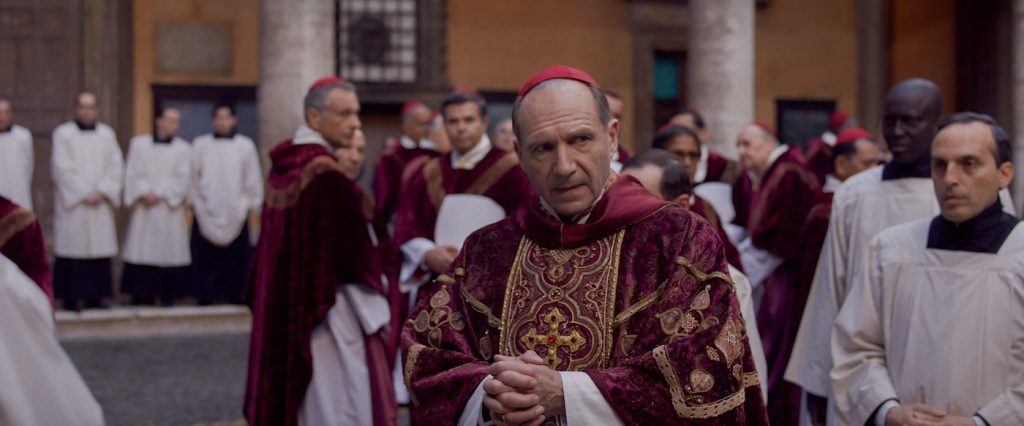
Where was the dining hall sequences filmed?
This canteen in a military academy in Rome. It had a great, low ceiling but sort of brutal vibe that suits this thriller. We cleaned it up and painted it, put some blinds on the windows. I think the soldiers were very happy with what we did and decided to keep it that way.
What are some of your favorite scenes?
There’s a beautiful choral piece in the Gold Room at the Palazzo Barberini, where Lawrence gives a big speech in Latin and Italian [the homily that marks the beginning of the conclave]. The Palazzo is a museum with this beautiful gold room with silk gold wallpaper, a massive fireplace, huge windows, and an ornate painted ceiling. Lizy Christl’s costumes are extraordinary, and the casting of all those background artists is amazing. You spin around this room of gold and listen to this wonderful music; I found that really moving. When Edward and I first visited there, we were both blown away by the scale. We just knew this needed to be part of our world. In my job, sometimes it’s just as important to know what not to do. That location already had a lot, so all I did was build a 15-foot crucifix artwork for the space.
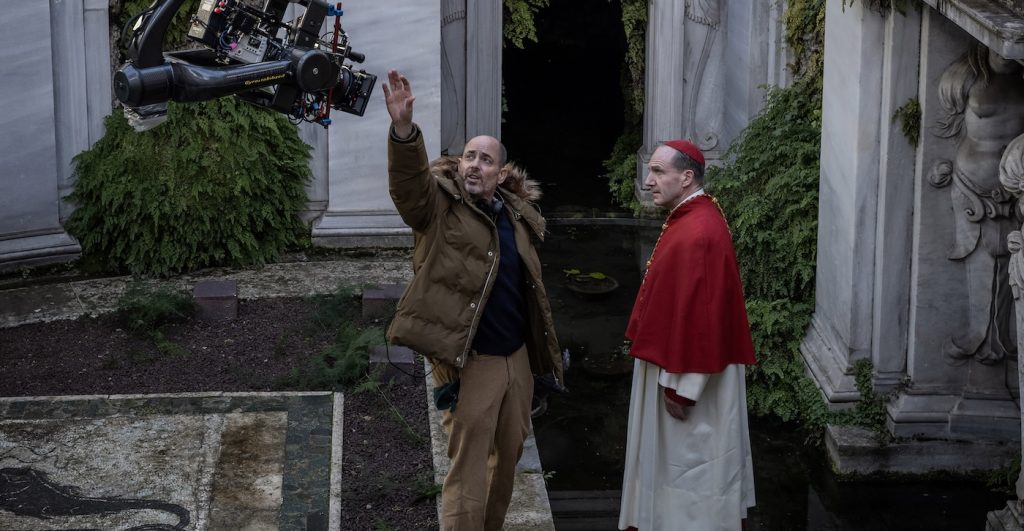
What other locations did you augment to fit in the story?
The room of tears at the very end, when the new Pope sits and wonders about his next movie, that’s an old farmhouse on the outskirts of Rome that we tidied up and painted that bright, deep red color. That was a very white stucco room underneath the Sistine Chapel that we painted red. The Conclave itself has adapted and changed the tradition over the years anyway, so we decided we could add some changes, too.
What about recreating parts of the Sistine Chapel—was that from an existing replica in storage at Cinecittà?
Cinecittà has some elements of it and ancient Rome on the backlot. So, we put that together in a slightly different configuration because we wanted our conclave to be more like a government, so the cardinals sat opposite each other. But the Sistine Chapel’s configuration wouldn’t have allowed that if we’d recreated it for real. Another known tradition is they’d carpet the Sistine Chapel to deaden the sound so that no one could hear their deliberations, but it’s usually beige. We thought that red on red adds to the drama, a bit of an homage to Cries and Whispers.
The cardinals vote until a two-thirds majority is achieved. That may sound boring on the page, but those sequences were suspenseful. How did you make the room where they vote interesting?
Very early on, Edward knew how all the chairs would be arranged, that each cardinal gets a pen, paper, a rule book, and their hat, those wooden spheres, and burning that paper. All those were specifically made to be very graphic. The DoP Stéphane Fontaine did a wonderful job creating those close-ups to give that sense of power and tradition. The stove that burns the papers is pretty well-documented, but we added a few more LED buttons to give it more intrigue and curiosity. We spent ages debating whether the graphics should be in English or Italian or should it just be a white sticker or a black sticker.
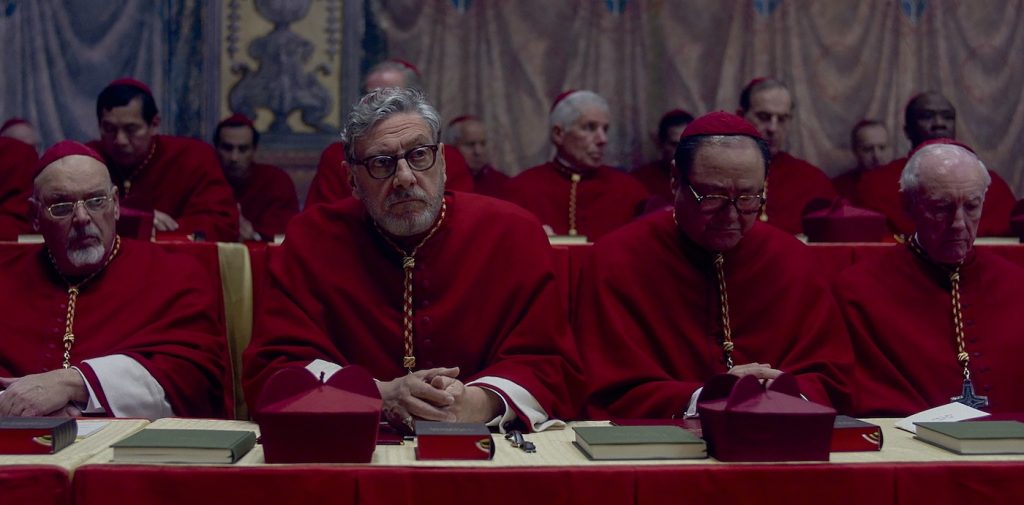
Did you have to recreate the “turtle fountain” as well?
There are turtles at the Vatican Gardens, and we found ornamental ponds in the Museo Etrusco in Rome. Filming there was tricky—there was a mosaic next it that no one could stand on, not even a turtle. So, we had to tiptoe around with them to get them to swim and acclimatize them to the water. We also filmed at the Royal Palace of Caserta in Napoli, where we see a turtle walking across an ornate marble floor.
In the beginning, when the Pope has just passed away, they immediately seal the room with a big red ribbon on the door.
We know it is sealed, but we made up how we would seal our door. We wanted it to be a little bit more dramatic, so I added the large metal knobs on the door to give that lovely shape. And then we found that brilliant machine that melts the wax. I think some could’ve have done it in the traditional way of lighting a candle and heating the wax, it was lovely to bring a contemporary element to it.
Conclave is in theaters now.
Featured image: (L to R) Brían F. O’Byrne as Cardinal O’Malley and Ralph Fiennes as Cardinal Lawrence in director Edward Berger’s CONCLAVE, a Focus Features release. Credit: Courtesy of Focus Features. © 2024 All Rights Reserved.


